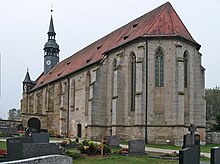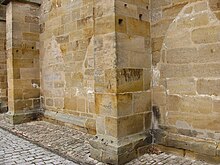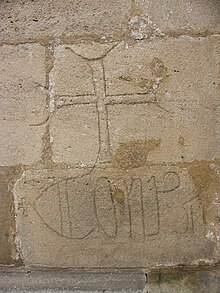Schlüsselau Monastery



The Schlüsselau Abbey in Schlüsselau , municipality of Frensdorf in the Archdiocese of Bamberg , was founded around 1280 by the Franconian noble free von Schlüsselberg and occupied by Cistercian women. The monastery complex was burned down during the Peasants' War and finally destroyed after its reconstruction in the Second Margrave War. The Bamberg Prince-Bishop Johann Philipp von Gebsattel built a representative official building next to the church, which has served as a pilgrimage church since the 16th century .
History of the monastery
Founding of a monastery
Eberhard IV von Schlüsselberg († 1283) and his sons Konrad I and Gottfried von Schlüsselberg founded a noble Cistercian monastery as a house monastery in the town of Seppendorf, now Schlüsselau , around 1280 . A deed of foundation is no longer available, but confirmation from Bamberg's Bishop Arnold von Solms in 1290 .
Several reasons contributed to the founding of the monastery. As an influential family, the Schlüsselbergers created their home monastery there with its own burial place. This happened as an expression of piety and for one's own salvation . In addition, the monastery offered the opportunity to accommodate unmarried daughters of one's own family as well as other noble families in the vicinity. The number of nuns was around 20, including some patrician daughters from the 14th century .
In 1295 the abbey was incorporated into the order of the Cistercian Sisters. The Abbot of Ebrach was replaced as a visitor by the Abbot of Langheim , from whom chaplains, confessors and conversationalists were also sent. The first nuns probably came from the Mariaburghausen monastery , to which the first abbess Gisela von Schlüsselberg , daughter of the monastery founder Eberhard, also belonged. Gottfried von Schlüsselberg († 1308) is the initiator of the church building , whose tomb has been preserved and points to his role as a founder. After him, Konrad II von Schlüsselberg appeared as a sponsor for "nostrum ac nostrorum progenitorum plantata". In 1330, as a feudal lord, he transferred the estate of Ulrich von Aisch in Uttstadt on the left bank of the Aisch to the Schlüsselau monastery. Under Gisela's successors Elisabeth von Eckersdorf (1309–1339) and Anna von Schlüsselberg (1339–1379), the Gothic church was completed in its present size by 1350 and consecrated to the Sorrowful Trinity .
Abbess Anna von Schlüsselberg
After Konrad II von Schlüsselberg, the last male Schlüsselberg to hold the monastery bailiwick, died in the battle against the burgrave of Nuremberg and the bishops of Bamberg and Würzburg in 1347, the monastery needed a new patron. In 1356 Konrad's presumed daughter Anna von Schlüsselberg , abbess of Schlüsselau since 1339, succeeded in obtaining an imperial letter of protection. Emperor Charles IV also confirmed the rights of the monastery, which had its own high judiciary.
Anna von Schlüsselberg (1339–1379) is regarded as the most important abbess, as she helped the monastery to acquire further property in the course of the Schlüsselberger inheritance disputes and, in addition to the legal, also to a sustainable economic basis. The isolated and comparatively modest monastery outlived the founding family and was spared further complications for a long time.
Further development
After the founding period shaped by Gisela von Schlüsselberg († 1308), Elisabeth von Eckersdorf († 1339) and Anna von Schlüsselberg († 1379), Anna von Zollern, Osanna von Streitberg, Kunigunde Stiebar, Elisabeth von Wiesenthau, Margarethe von Egloffstein, Brigitta Haut, Katharina von Aisch, Ursula von Truppach and finally Brigitta von Stiebar (1526 to 1554).
Over time, the number of conversers or lay sisters who did the farm work decreased. Private ownership among the nuns became common. In times of crisis, lease income was partially absent.
In the early 16th century, the pilgrimage to the Sorrowful Most Holy Trinity began and continues to this day.
Decline of the monastery
The monastery was ravaged several times during the Peasants' War and destroyed by fire in 1525. The penultimate abbess Ursula von Truppach and the nuns had fled to the Schlüsselauer Hof on the Kaulberg in Bamberg. The abbess died in exile in Bamberg, and the nuns did not return until 1528. The monastery was rebuilt according to the historical model. During the Second Margrave War , however, the monastery was destroyed again on April 22, 1553 by the Margrave Albrecht Alcibiades . A revitalization did not take place, instead the monastery was handed over to the bishopric of Bamberg by the last superior Brigitta von Stiebar in return for an annuity . The Hochstiftsverwaltung moved in the properties and set up the office in Schlüsselau .
Failed resuscitation
In the 20th century, an attempt was made to give the monastery buildings an order again. In 1949 seven Carmelite Sisters (OCarm) from Holland moved into the historic building, because of the inadequacies they found they left Schlüsselau again in 1968 and set up new premises in Erlangen-Büchenbach .
Monastery church
Under Prince-Bishop Johann Philipp von Gebsattel , who also dedicated himself to the expansion of the Giechburg , the church was restored in the Renaissance style from 1603 . The nuns' choir typical of the Cistercian women and the elevated nave were omitted during the reconstruction. The rebuilt convent building received an ornate facade with a gate in the Renaissance style and a representative forecourt.
The interior of the church dates from around 1730, with Martin Walther from Bamberg taking part . Further construction work took place between 1753 and 1765, the westwork was rebuilt in 1895.
Several furnishings from the monastery period were also put into the church. In the choir, formerly in the middle of the presbytery , is the cenotaph of the church founder Gottfried von Schlüsselberg with the large coat of arms of the von Schlüsselberg family . The inscription reads "Anno domini MCCCVIII nonas Junii obiit dilectus Gotfridus de Sluzzelberg fundator ecclesie istius", that means: In the year of the Lord 1308 the honorable Gottfried von Schlüsselberg, the founder of this church, died on June 5th (see picture).
The altar sheet on the high altar was adopted, but it was lengthened in height and painted over; the minor figures on the high altar are by Franz Anton Schlott . The painful trinity from the high altar from 1603, also known as the mercy seat , is on the southern inner outer wall. A larger than life crucifix with the evangelist symbols on the ends of the cross dates from the 14th century. A vespers group is dated around 1420, it is a Nuremberg work made of baked clay. Twelve Passion reliefs from the 16th century were probably originally part of an altar. A painting depicting the holy clan follows the tradition of the successors of Dürer from the 16th century.
literature
- Renate Baumgärtel: Prince-Bishop Johann Philipp von Gebsattel and the church in Schlüsselau , Bamberg 1997
- Renate Baumgärtel: The reconstruction of the Schluesselau monastery , in: Günther Dippold: On the trail of the past , Bamberg 2006
- Georg Dehio: Bavaria I Franconia . Deutscher Kunstverlag 1979. p. 750.
- Joachim Hotz: Cistercian monasteries in Upper Franconia . In: Great Art Guides . tape 98 . Schnell and Steiner, Munich, Zurich 1982, ISBN 3-7954-0842-3 , pp. 80-86 .
- Stefan Nöth: Ager clavium. The Cistercian Monastery in Schlüsselau 1280-1554 (Historischer Verein Bamberg, supplement 16), Bamberg 1982
- Paul Oesterreicher: The Reichsherr Gottfried von Schlüsselberg. A historical outline. With the genealogical tables of the imperial lords of Schlüsselberg and von Weischenfeld . Publisher of the author. Bamberg 1821. Google
- Hans Paschke: The Giechburg in its heyday under Prince-Bishop Johann Philipp von Gebsattel (1599-1609) and the reconstruction of the Schlüsselau Monastery . In: 111th report of the historical association for the maintenance of the history of the former prince-bishopric of Bamberg . Bamberg 1975. pp. 329-346.
- Hans Roser: Monasteries in Franconia . Eulen Verlag, Freiburg 1988, ISBN 3-89102-108-9 , pp. 225-227 .
- Erich Schneider: Monasteries and monasteries in Mainfranken , Würzburg 1993, pp. 168–170
- Gustav Voit: The Schlüsselberger. History of a Frankish noble family . Nuremberg 1988.
References and comments
- ↑ Counting method IV. After Greifensteiner Eberharden. The House of Bavarian History counts him as Eberhard II von Schlüsselberg (renamed in 1216 by Eberhard I.) See history of Kloster Schlüsselau (HdBG)
- ↑ Paul Oesterreicher: The Reichsherr Gottfried von Schlüsselberg. A historical outline. With the genealogical tables of the imperial lords of Schlüsselberg and von Weischenfeld . Publisher of the author. Bamberg 1821. Google
- ↑ The grave inscription calls Gottfried "founder of this church".
- ^ Translation: "His and his ancestors' foundation". Source: Gustav Voit near Neideck Castle (Schmittroth)
- ↑ See website of Uttstadt near Adelsdorf ( Memento of the original from December 6, 2013 in the Internet Archive ) Info: The archive link was automatically inserted and not yet checked. Please check the original and archive link according to the instructions and then remove this notice.
- ↑ See Schlüsselau at Foracheim
- ↑ Hans Paschke: The Giechburg in its heyday under Prince Bishop Johann Philipp von Gebsattel (1599-1609) and the reconstruction of the Schlüsselau Monastery . In: 111th report of the historical association for the maintenance of the history of the former prince-bishopric of Bamberg . Bamberg 1975, pp. 333-336.
Web links
- Monasteries in Bavaria: Schlüsselau - a place of female mysticism (House of Bavarian History)
- Schlüsselau near Foracheim
Coordinates: 49 ° 47 ′ 28 " N , 10 ° 54 ′ 37.1" E


